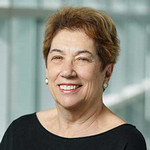Simchat Torah, Vienna Style
Sept. 10, 2015
By Shulamit Reinharz
A year ago, I spent Simchat Torah in Vienna when I travelled there to participate in the Vienna Project, a multi-tiered program created by Karen Frostig, a Boston-based Jewish artist and daughter of a Viennese family who had to flee during World War II. The point of her project was to engage many current Viennese citizens in a remembrance of their past. I arrived the morning before Simchat Torah with several other members of Frostig's U.S. advisory board.
That night, we went to The Stadttempel, the main Viennese synagogue, one of the few Jewish structures that survived Kristallnacht. We saw Austrian soldiers with machine guns — this time to protect the Jews, not to mow them down. The pair of Jewish men at the door to the synagogue foyer checked our names against a list of prescreened invited guests.
The women were shepherded to the women's balconies, one that was rather close in height to the floor of the main sanctuary, but constructed as a semi-circle hovering above the main area. There were quite a few women in the balcony but certainly many fewer than the men below. It was wonderful to look over the railing and see the "the synagogue" overflowing with men and boys of all ages. I put "the synagogue" in quotes, because it felt that the synagogue was down there, not up where we were.
The service began and I noticed that several American women seemed to know the prayers. The other women — presumably from the Viennese congregation — either did not pray or kept quiet. Many were talking or caring for children or grandchildren. There were a few Simchat Torah flags for us to wave, but we women were entirely peripheral to what was going on.
Finally, the time came to take all the Torah scrolls from the ark. They were handed to the men and post-bar mitzvah boys to carry as they circled the lectern over and over, sometimes in a frenzy, singing loudly with joy and camaraderie. We women had absolutely nothing to do but be happy for them.
After a while, one of the leaders of the congregation came to where the women were sitting to wish us a Happy Holiday. I asked him if he could bring us one Torah scroll so that the women could walk around with it in the balcony without intruding onto the synagogue floor action. We wouldn't make any noise to attract attention. He consulted with someone to see if we would be permitted to celebrate Simchat Torah in the manner of men. When he returned, the answer was "no." Adding, "You American women are asking for something we don't do." How sad, I thought, to deny Jews the right to experience joy on Simchat Torah.
I guess we have a long way to go if we want to help create vibrant European communities where women can have meaningful roles. The HBI recommends offering Jewish education to girls and women so that they can become dynamically involved in public holiday celebrations as well as other aspects of Judaism. One European organization working on women's roles in Judaism is Bet Deborah. But the organization that seems most attuned to the role of women in Orthodox life is JOFA (Jewish Orthodox Feminist Alliance), which now has a branch in London as well as its base in the U.S.
We applaud JOFA for jumping into this void by offering a webinar on the very topic that bothered me so much last year. Entitled "Engaging Women on Simchat Torah in your Community," on Sept. 10, the participants discussed ways "to create engaging, meaningful and spiritual opportunities for women in traditional communities during Simchat Torah." As JOFA advertised, "Make this year’s Simchat Torah a meaningful experience for women in your communities." I hope someone from Vienna tuned in.
 Shulamit Reinharz, founder and director of the Hadassah-Brandeis Institute, is the Jacob Potofsky Professor of Sociology and director of the Women’s Studies Research Center.
Shulamit Reinharz, founder and director of the Hadassah-Brandeis Institute, is the Jacob Potofsky Professor of Sociology and director of the Women’s Studies Research Center.